Duchenne Muscular Dystrophy (DMD) – Empowering DMD Management: Expert Insights
– Market Insight, Clinical trial, Product Analysis, Patent Analysis, Competitive Analysis and Market Forecast – 2024-2034
Duchenne Muscular Dystrophy (DMD) is a debilitating genetic disorder characterized by progressive muscle degeneration and weakness, primarily affecting male individuals. It stems from mutations in the dystrophin gene, leading to the absence or dysfunction of dystrophin protein critical for maintaining muscle cell integrity. This comprehensive overview focuses on the management and treatment strategies for DMD, emphasizing current therapeutic approaches and supportive care.
Diagnosis
Diagnosis of DMD entails a comprehensive assessment involving various clinical and laboratory tests. Elevated levels of creatinine kinase, characteristic muscle biopsy findings, and genetic analysis play pivotal roles in confirming the diagnosis and determining disease severity. Additionally, cardiac evaluations are essential to assess and monitor cardiomyopathy, a common complication of DMD.
Corticosteroids, such as prednisolone and deflazacort, are cornerstone pharmacological agents in the management of DMD. These medications effectively delay muscle weakness progression, improve lung function, and prolong survival. Early initiation of cardioprotective medications, including ACE inhibitors and beta-blockers, mitigates the progression of cardiomyopathy and reduces the risk of heart failure.
Rehabilitation and physical therapy constitute integral components of DMD management, aiming to optimize functional abilities and prevent musculoskeletal complications. Tailored exercise programs, stretching exercises, and orthotic interventions help maintain mobility, alleviate contractures, and delay the onset of scoliosis. Furthermore, respiratory muscle training and pulmonary interventions enhance respiratory function and delay respiratory decline.
In cases of severe contractures and progressive scoliosis, surgical interventions may be warranted to alleviate musculoskeletal deformities and improve functional outcomes. Orthopedic surgeries, including tendon releases and spinal fusion procedures, address contractures and spinal curvature, respectively, thereby enhancing mobility and optimizing respiratory function.
Mobility aids, such as braces, canes, and wheelchairs, facilitate ambulation and promote independence in individuals with DMD. Additionally, respiratory support modalities, including non-invasive ventilation and cough-assist devices, play crucial roles in managing respiratory insufficiency and maintaining optimal pulmonary function.
Ongoing research into gene therapy, exon skipping, and other innovative treatments offers promise for potential disease-modifying therapies in the future. However, until these therapies become available, early intervention and comprehensive supportive care remain fundamental in maximizing function and enhancing the quality of life for individuals with DMD.
In conclusion, DMD management necessitates a multidisciplinary approach encompassing pharmacological interventions, rehabilitation, surgical interventions, and supportive therapies. Early initiation of comprehensive treatment strategies, coupled with regular monitoring and proactive interventions, is paramount in optimizing outcomes and enhancing the quality of life for individuals affected by DMD. Continued research efforts are imperative for advancing therapeutic modalities and ultimately finding a cure for this debilitating genetic disorder.

Figure 1: Credits: >>
In order to maintain competitiveness in the field of Duchenne Muscular Dystrophy (DMD) over the short to mid-long term, it is essential to have a comprehensive grasp of the DMD developmental pipeline. This necessitates staying abreast of the evolving landscape, competitor strategies, and upcoming advancements.
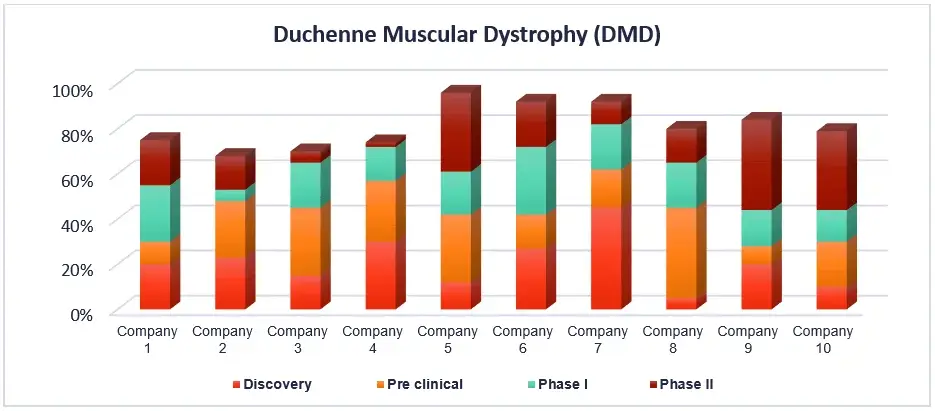
Figure 2: Ongoing Research
Profiles of key stakeholders propelling advancements in Duchenne Muscular Dystrophy (DMD) solutions provide valuable insights into their financial status, product portfolios, and recent innovations within the field.
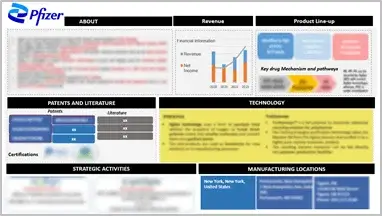
Figure 3: Company Profile
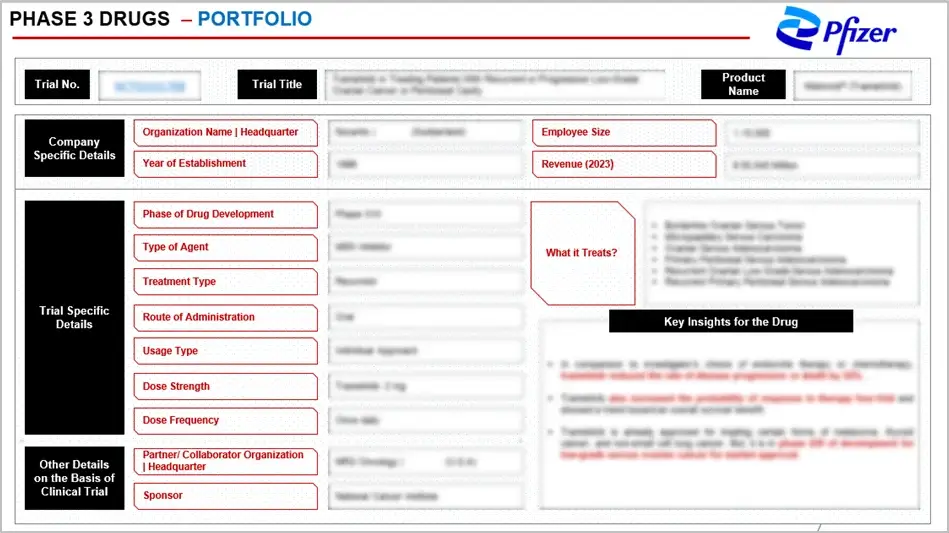
Figure 4: Product Profile
This report examines patents related to Duchenne Muscular Dystrophy (DMD), pinpointing significant innovations and underscoring opportunities for improvement or collaboration within the field.
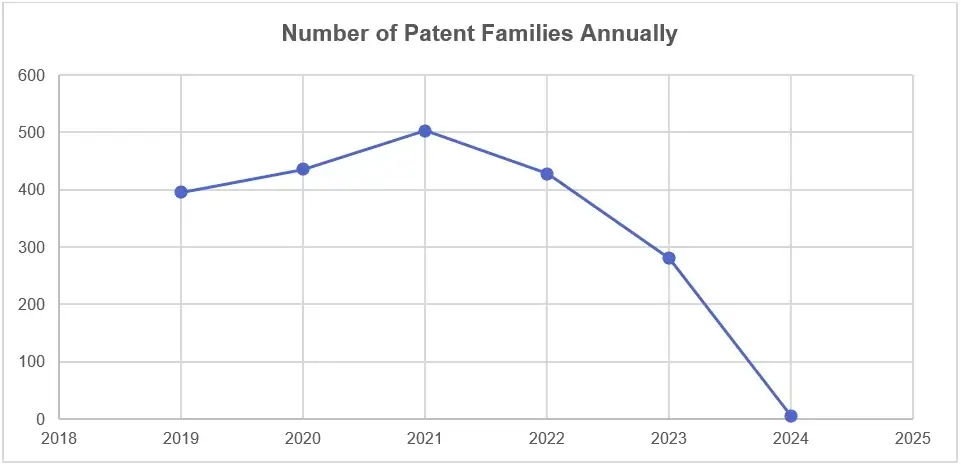
Figure 5: Yearly analysis of Patent families in DMD domain
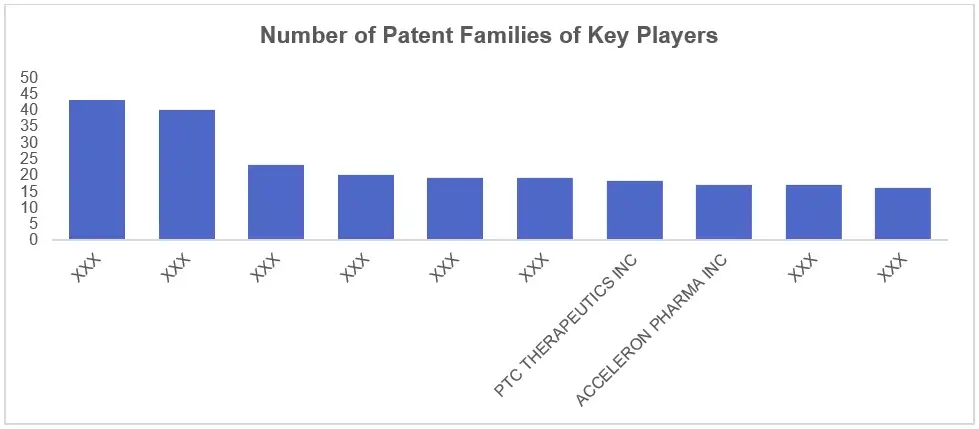
Figure 6: Patent stockpile of Key Players in DMD domain
This report on Duchenne Muscular Dystrophy (DMD) anticipates forthcoming advancements, delineates pathways for expansion, and offers crucial insights into market dynamics, encompassing aspects such as scale, revenue forecasts, and growth opportunities.
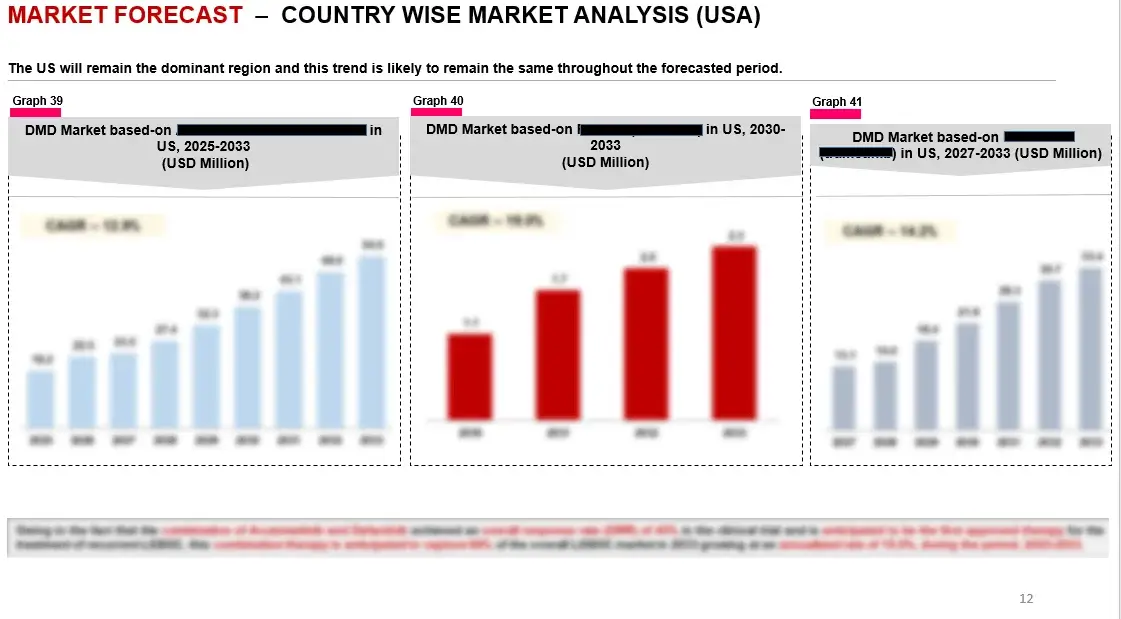
Figure 7: Market Forecast
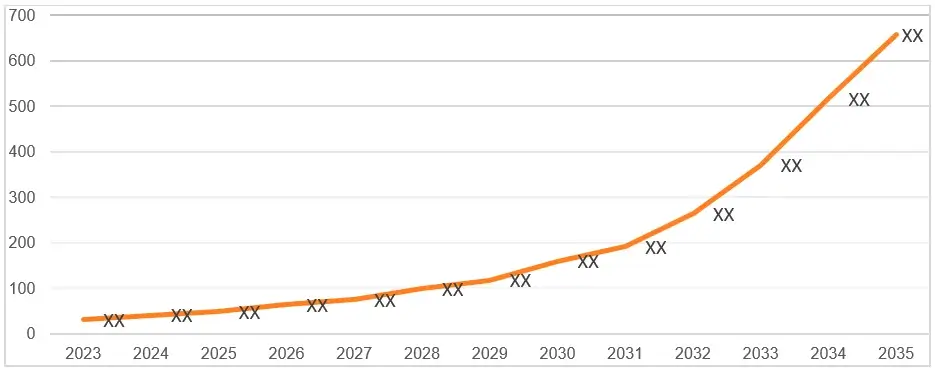
Figure 8: DMD: Market, 2023-2035 (USD Million)
(Segmented in terms of the financial growth)
In this Duchenne Muscular Dystrophy (DMD) market report, the competitive landscape section offers a thorough overview of key market players, their market shares, and concise profiles detailing strengths, weaknesses, and strategic approaches within the DMD domain. Additionally, it includes the service of competitive benchmarking to provide valuable insights into comparative performance and industry standards.
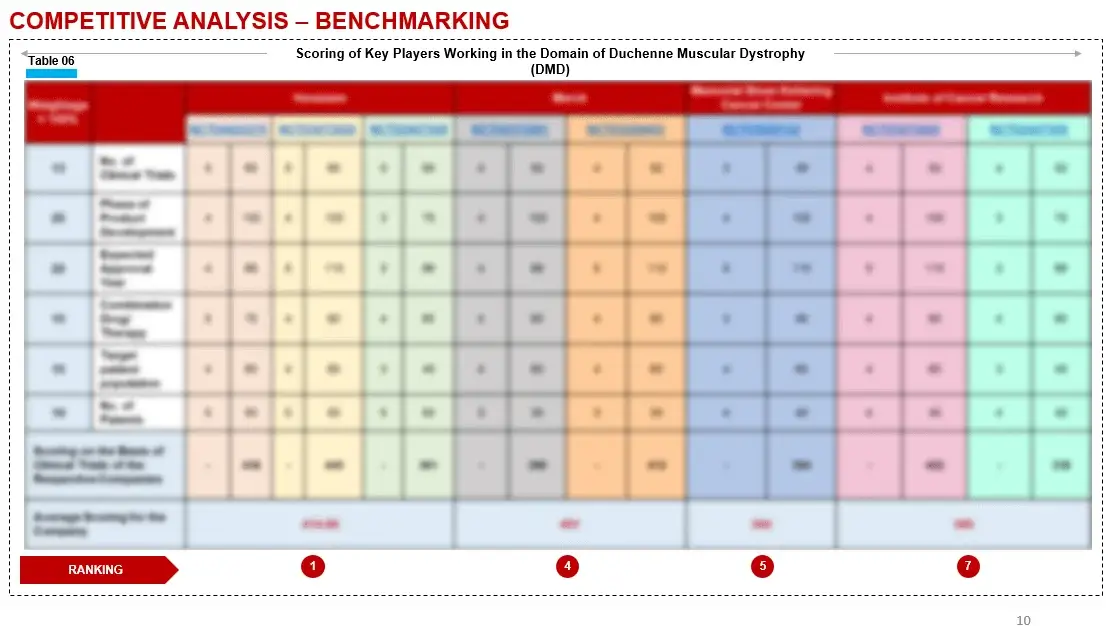
Figure 9: Benchmarking Parameters
In order to give the most precise estimations and forecasts, Wissen Research uses an extensive and iterative research approach that is focused on reducing deviation. The company blends top-down and bottom-up methodologies for market segmentation and quantitative estimation. In addition, data triangulation, which examines the market from three separate angles, is a recurrent topic present in all of our research studies. Important components of the approach used for all of our studies include the following:
Preliminary data mining
On a wide scale, unprocessed market data is collected. Continuous data filtering makes sure that only verified and authenticated sources are taken into account. Additionally, data is extracted from a wide range of reports in our repository and from a number of reputable premium databases. We gather information from raw material suppliers, distributors, and purchasers to help with this since understanding the entire value chain is crucial for a thorough understanding of the market.
Surveys, technical symposia, and trade magazines are used to gather information on technical concerns and trends. Technical information focusing on white space and freedom of movement is also obtained from an intellectual property standpoint. Additionally, information on the industry’s drivers, constraints, and pricing patterns is obtained. As a result, a variety of original data are included in the material that is then cross-validated and certified with published sources.
Statistical model
We use simulation models to generate our market projections and estimates. Every study receives a special model that is tailored to it. Data for market dynamics, the technology environment, application development, and pricing patterns are gathered and supplied into the model all at once for analysis. The relative relevance of these factors is investigated, and their impact on the forecast period is assessed, using correlation, regression, and time series analysis. The process of market forecasting combines technological analysis with economic strategies, practical business acumen, and subject expertise.
Econometric models are frequently used for short-term forecasting, but technology market models are typically employed for long-term forecasting. These are based on a confluence of the business environment, regulatory environment, economic projection, and technical landscape. In order to develop global estimates, it is preferable to estimate markets from the bottom up by integrating data from key regional markets. This is required to ensure accuracy and a complete comprehension of the subject. Among the variables taken into account for forecasting are:
Regulations and anticipated developments
We give these criteria weights and use weighted average analysis to assess their market influence in order to calculate the anticipated market growth rate.
Primary research | Secondary research |
· Manufacturers · Technology distributors and wholesalers · End-user surveys · Consumer surveys | · Company reports and publications · Government publications · Independent investigations · Economic and demographic data · Online searches · Research reviews · Reference customers |
1. Executive Summary and Introduction
1.1 Overview of Duchenne Muscular Dystrophy (DMD)
1.1.1 Definition and Classification of DMD
1.1.2 Scope and Applications of DMD Research
1.1.3 Benefits and Current State of DMD Therapies
1.2 Key Findings
1.3 Market Insights and Highlights
1.4 Research Background
1.5 Scope and Methodology
2. Technological Landscape of DMD
2.1 Types of DMD
2.1.1 Classification by Genetic Mutation
2.1.2 Classification by Clinical Manifestations
2.2 Genetic Composition and Characteristics
2.3 Emerging Technologies in DMD Research
3. Market Dynamics
3.1 Market Drivers and Challenges
3.2 Regulatory Landscape in DMD Research
4.Patent Analysis
4.1 Top Assignees in DMD Technology
4.2 Geography Focus of Top Assignees
4.3 Legal Status of DMD Patents
4.4 Assignee Segmentation
4.5 Network Analysis of Top Collaborating Entities in DMD Patent Applications
4.6 Technology Evolution in DMD
4.7 Key Patents in DMD
4.8 Patent Trends and Innovations
4.9 Key Players and Patent Portfolio Analysis
5. Clinical Trial Analysis
5.1 Overview of DMD Clinical Trials
5.2 Analysis by Trial Registration Year
5.3 Analysis by Phase of Development
5.4 Analysis by Number of Patients Enrolled
5.5 Analysis by Status of Trial
5.6 Analysis by Study Design
5.7 Analysis by Intervention Type
5.8 Analysis by Geography
5.9 Analysis by Key Sponsors/Collaborators
6. Market Forecast (2024-2034)
6.1 Methodology
6.2 Assumptions
6.3 Projected Growth of DMD Market (2024-2034)
6.3.1 Global DMD Market (2024-2034)
6.3.1.1 By Therapeutic Approach
6.3.1.1.1 Molecular-based Therapies
6.3.1.1.1.1 Mutation Suppression
6.3.1.1.1.2 Exon Skipping
6.3.1.1.2 Steroid Therapy
6.3.1.1.2.1 Corticosteroids
6.3.1.1.3 Other Therapeutic Approaches
6.3.1.2 By Distribution Channel
6.3.1.2.1 Hospital pharmacies
6.3.1.2.2 Drug store and retail pharmacies
6.3.1.2.3 Online providers
6.3.2 Global Market Value Forecast in North America, Europe, and Asia Pacific (2024-2034)
6.3.2.1 By Therapeutic Approach
6.3.2.1.1 Molecular-based Therapies
6.3.2.1.1.1 Mutation Suppression
6.3.2.1.1.2 Exon Skipping
6.3.2.1.2 Steroid Therapy
6.3.2.1.2.1 Corticosteroids
6.3.2.1.3 Other Therapeutic Approaches
6.3.2.2 By Distribution Channel
6.3.2.2.1 Hospital pharmacies
6.3.2.2.2 Drug store and retail pharmacies
6.3.2.2.3 Online providers
7. Competitive Landscape
7.1 Benchmarking Parameters
7.2 Scoring of Different Companies
7.3 Top Company Profiles
7.3.1 F Hoffmann-La Roche AG
7.3.2 FibroGen Inc.
7.3.3 GlaxoSmithKline plc
7.3.4 Pfizer Inc.
7.3.5 Nippon Shinyaku Co., Ltd
7.3.6 Sarepta therapeutics
7.3.7 Company 7
7.3.8 Company 8
7.3.9 Company 9
7.4 Product Portfolio Analysis
7.5 Recent Developments and Strategies
8. Future Outlook and Market Opportunities
8.1 Technological Advancements in DMD Research
8.2 Unmet Needs and Potential Market Gaps
9. Conclusion
10. Appendix
10.1 Glossary of Terms
10.2 List of Abbreviations
S.no | Key Highlights of Report | |
1. | Patent Analysis | · Top Assignee · Geography focus of top Assignees · Assignee Segmentation · Technology Evolution · Key Patents · Application and Issued Trend · Key technology |
2. | Market Analysis | · Current Treatment Options · Emerging Therapies and Research Developments (by product analysis and scientific analysis) · Strategic activities · Therapeutic activity of drugs · Company portfolio · Detailed profiles of the key players that are engaged in the development of approved drugs |
3. | Clinical Trials | · Analysis of clinical trial through graphical representation · Coverage of treatments from pre-clinical phases till commercialization (also including terminated and completed studies) |
4. | Forecast | · Detailed comprehension of the historic, current and forecasted trend of market by analysis of impact of these treatments on the market |
5. | Opportunity Analysis | · Technology evolution based on problem solution · Potential licensees · Geography of suppliers · Treatment trends · Unmet needs · SWOT · Drivers and barriers |
6. | KOLs | · A detailed analysis and identification of the Key Opinion Leaders (KOLs), shortlisted based on their contributions |
LIST OF FIGURES
Figure number | Description |
Figure 1 | Terminology of Duchenne Muscular Dystrophy (DMD) Over The Years |
Figure 2 | Duchenne Muscular Dystrophy (DMD)– History and Present |
Figure 3 | Projection of Duchenne Muscular Dystrophy (DMD) till 2034 in different geographies |
Figure 4 | Technology Categorization For Duchenne Muscular Dystrophy (DMD) therapies |
Figure 5 | Recent Technology Trends in Duchenne Muscular Dystrophy (DMD) therapies |
Figure 6 | Technology Evolution in Duchenne Muscular Dystrophy (DMD) therapies |
Figure 7 | Geographical Distribution of Patents of Top Assignees |
Figure 8 | Assignee Segmentation (Companies) |
Figure 9 | Assignee Segmentation (Educational Establishment) |
Figure 10 | Patent Based Key Insights Of xx |
Figure 11 | Patent Based Key insights of xx |
Figure 12 | Patent Based Key insights of xx |
Figure 13 | Geographic Distribution of the Universities/Research Organizations Filling Patents On Various Technology advancements |
Figure 14 | Key Summary Regarding the Patent Filing On Duchenne Muscular Dystrophy (DMD) |
Figure 15 | Product Pipeline of Different therapeutic approaches with Companies Name |
Figure 16 | Portfolio for Government Approved Hepatic medications |
Figure 17 | Key Growth Drivers for Duchenne Muscular Dystrophy (DMD) Market |
Figure 18 | Restraints for Duchenne Muscular Dystrophy (DMD) Market |
Figure 19 | xx Portfolio (Top Player) |
Figure 20 | xx Portfolio (Top Player) |
Figure 21 | xx Portfolio (Top Player) |
Figure 23 | xx Portfolio (Top Player) |
Figure 24 | xx Portfolio (Top Player) |
Figure 25 | xx Portfolio (Start-up) |
Figure 26 | xx Portfolio (Start-up) |
Figure 27 | xx Portfolio (Start-up) |
Figure 28 | Strategic Activities Including Collaboration, Partnerships and Acquisitions |
Figure 29 | Research Methodology for Patent, Selection and Analysis |
LIST OF GRAPHS
Graph number |
Description |
Graph 1 | Problem Solution Analysis |
Graph 2 | Top Assignees in Duchenne Muscular Dystrophy (DMD) treatment therapy |
Graph 3 | Technology Focus of Top Assignees (IPC-CPC Classes) |
Graph 4 | Top Countries of Origin of Patents |
Graph 5 | New entrants in DMD field |
Graph 7 | Legal Status |
Graph 8 | Most Cited Patents |
Graph 9 | Patents with Largest Invention Families |
Graph 10 | Most Claim-Heavy Patents |
Graph 11 | Filing Trends |
Graph 12 | Weighted Scores for Top xx Players According to Benchmarking Criteria |
Graph 13 | Duchenne Muscular Dystrophy (DMD) (CAGR: 2024-2034) |
Graph 14 | Duchenne Muscular Dystrophy (DMD) Market Share: Distribution by Key Geographical Area, 2024-2034 |
LIST OF TABLES
Table number | Description |
Table 1 | Parameters included and excluded for conducting the analysis |
Table 2 | Technology Classes with Definitions |
Table 3 | Patent Litigation |
Table 4 | Highest Market Valued Patents |
Table 5 | SWOT Analysis of Top 3 Players |
Table 6 | Parameters and their score for Benchmarking |
Table 7 | Weighted scores for top 5 players according to benchmarking criteria |
© Copyright 2024 – Wissen Research All Rights Reserved.